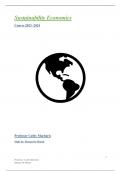Class notes
sustainability economics
- Course
- Institution
This course contains all the notes from the lectures / also from the guest lectures. The course is given in the 3rd year of handelsingenieur but also in the 2nd year of the master business engineering and technology I passed this course with an 18/20 by using these notes
[Show more]



